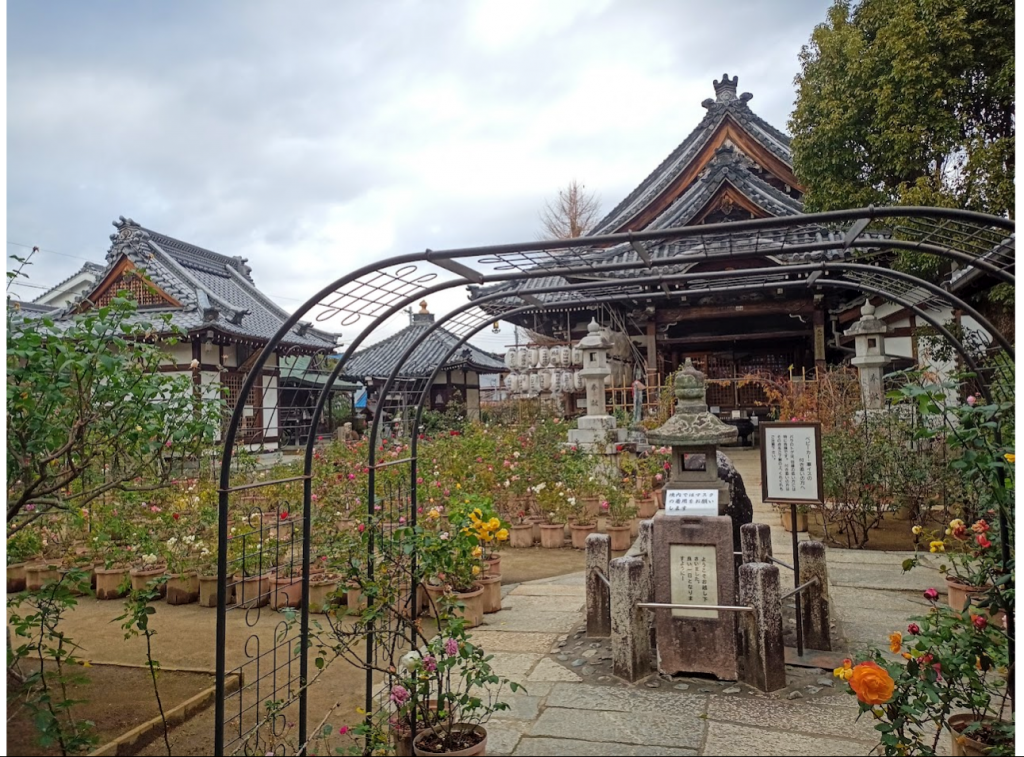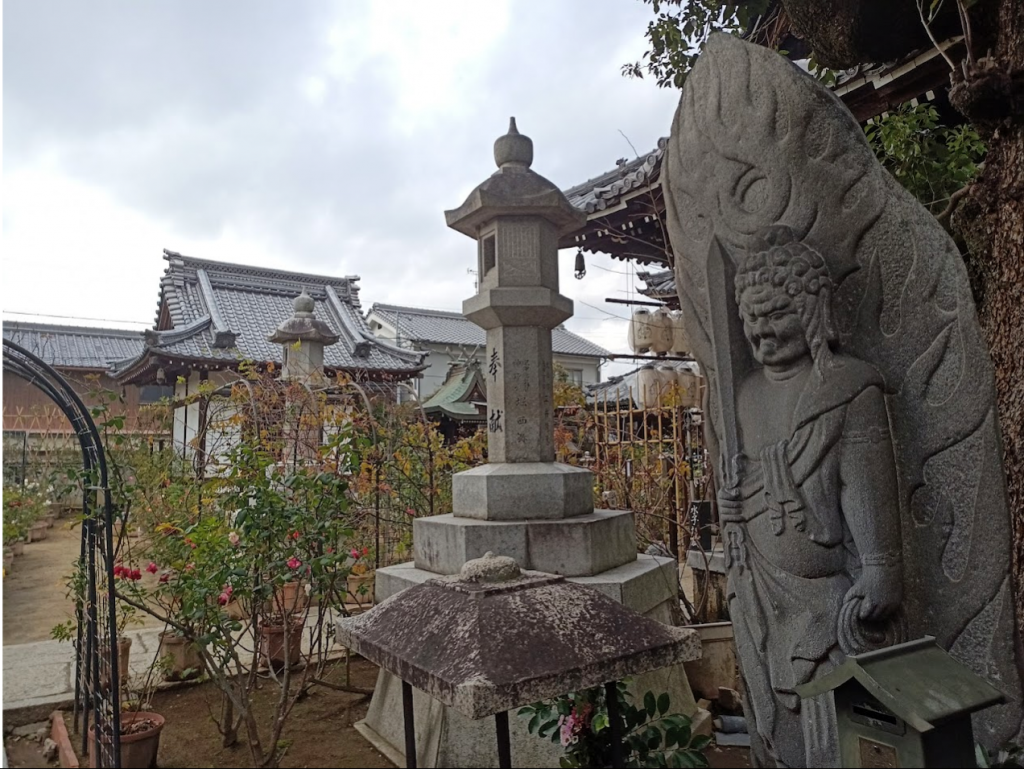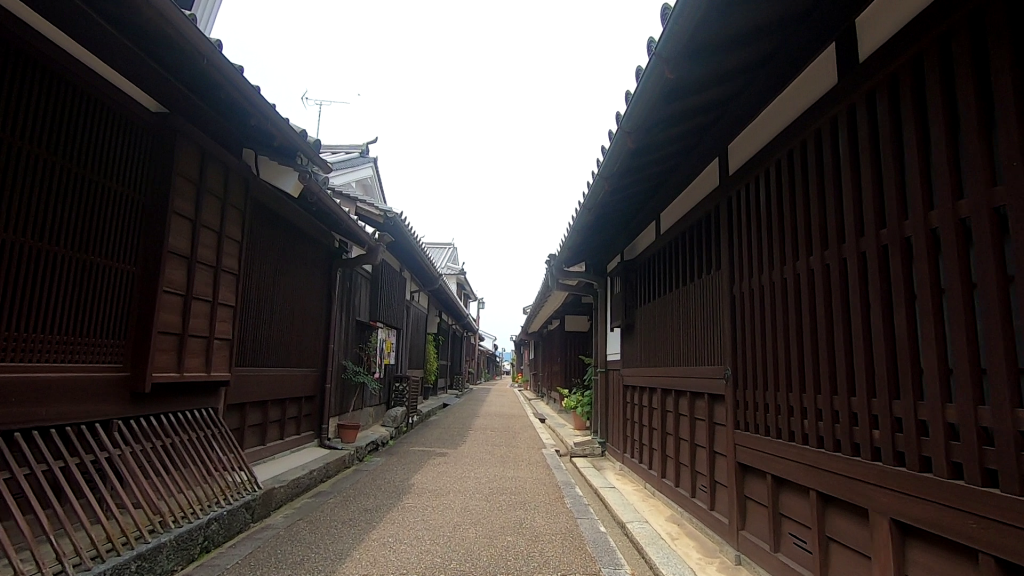Kashihara City’s Ofusa Kannon Temple
2022/01/14
Japan is a country well known for its famous historical sites that often feature impressive design, ancient legacies, and associations with larger-than-life figures. Nara Prefecture contains many of these types of sites, including the Great Buddha Hall of Todai Temple, and the world’s oldest standing wooden structures found in Horyu Temple. Sites such as these are worthy of the attention they get, but they often overshadow lesser-known spots that may be less jaw-dropping, but still posses their own unique beauty that makes them worth the time to visit; Ofusa Kannon Temple in Kashihara City is one such place.

View from just inside the entrance to Ofusa Kannon Temple (taken in December).
Also known as the the “Temple of Flowers and Wind Chimes”, Ofusa Kannon Temple is nestled in among a neighborhood of residential homes on the south end of Yagi Town in Kashihara City. The reason for this nickname is made obvious upon entering the grounds when you are greeted with a garden bursting with flowers, including roses of all colors. The groundskeepers of the temple seem to take a liberal philosophy toward reigning in the stems and vines of plants, allowing them to to grow into (and over) the walking paths, giving the area the feel of a wild community garden. This blossoming environment was created to resemble the paradise of the Buddha world, and it is for this reason that the Ofusa Kannon is also known as the “Flower Mandala Temple.”
In Japan’s hot and humid summer, Ofusa Kannon Temple hosts it’s annual Wind Chime Festival for 2 months (July & August), which takes the form of thousands of chimes being hung throughout the temple complex. During this time, a gentle breeze gives the grounds of the temple a surreal feel as a symphony of pleasant tones fills the air from all directions.

A statue of the deity Fudo Myo, otherwise known as “Ankala”, stands before the the main hall of the temple.
Background
The story of Ofusa Kannon Temple’s founding dates back to the Edo Period when the area on which the temple is located used to just contain a pond known by the name of “Koigafuchi.” One day, a young girl by the name of Ofusa was walking in the area when she saw the incredible image of the Buddhist Deity Kannon (the Goddess of Mercy) sitting atop a white turtle. After being witness to this holy image, Ofusa decided to found a small temple hall at the site of its appearance, which would become known over time as Ofusa Kannon Temple. In the Meiji Period, community members raised funds to build the temple complex that is still in use there to this day.
Beyond the flower garden and main hall, the complex also features a tea house, a pond with many resident turtles that symbolize the deity Kannon, and another pond which is home to large carp.

One of the main things that sets this temple apart from other, more well-known temples is that it has a reputation for being preserved and built up by the common people, not famous historical figures or powerful and wealthy patrons. Furthermore, the modern-day surrounding area between Ofusa Kannon Temple and Yamato-yagi Station has also been preserved, including traditional structures in the old travel hub of Yagi Town and the merchant town of Imai-cho, wherein around 500 traditional buildings are still in use today.

Street running through the nearby Imai Town area.
Access:
So, if you are planning on visiting Nara and seeing other famous historical sights in the area, why not put Ofusa Kannon Temple on your itinerary as well? It is only a 15-20 minute walk from Yamato-yagi Station (or a quick bike ride, using one of Kashihara Navi Plaza’s rent-a-cycle bikes!). It is also located on the bike route to Asuka Village (following the Asuka River) and near the Fujiwara-kyo Ancient Capital ruins site.
Entering the temple grounds (containing the flower gardens, wind chimes, and other lovely scenery) is free, but going inside the main hall to see the temple’s statue of the deity Kannon requires a small fee.

01
FIND YOUR FAVORITE
TRIP ON OUR WEBSITE.
SEND US AN INQUIRY.

02
PERSONALIZE THE TRIP
TO YOUR INTERESTS
WITH OUR CONSULTANT.

03
20% DEPOSIT TO CONFIRM.
BALANCE PRIOR TO ARRIVAL.
PAYMENT BY CC OR TT.

04
WE WILL
MEET YOU
AT THE AIRPORT.

05
DISCOVER THE
TREASURES!